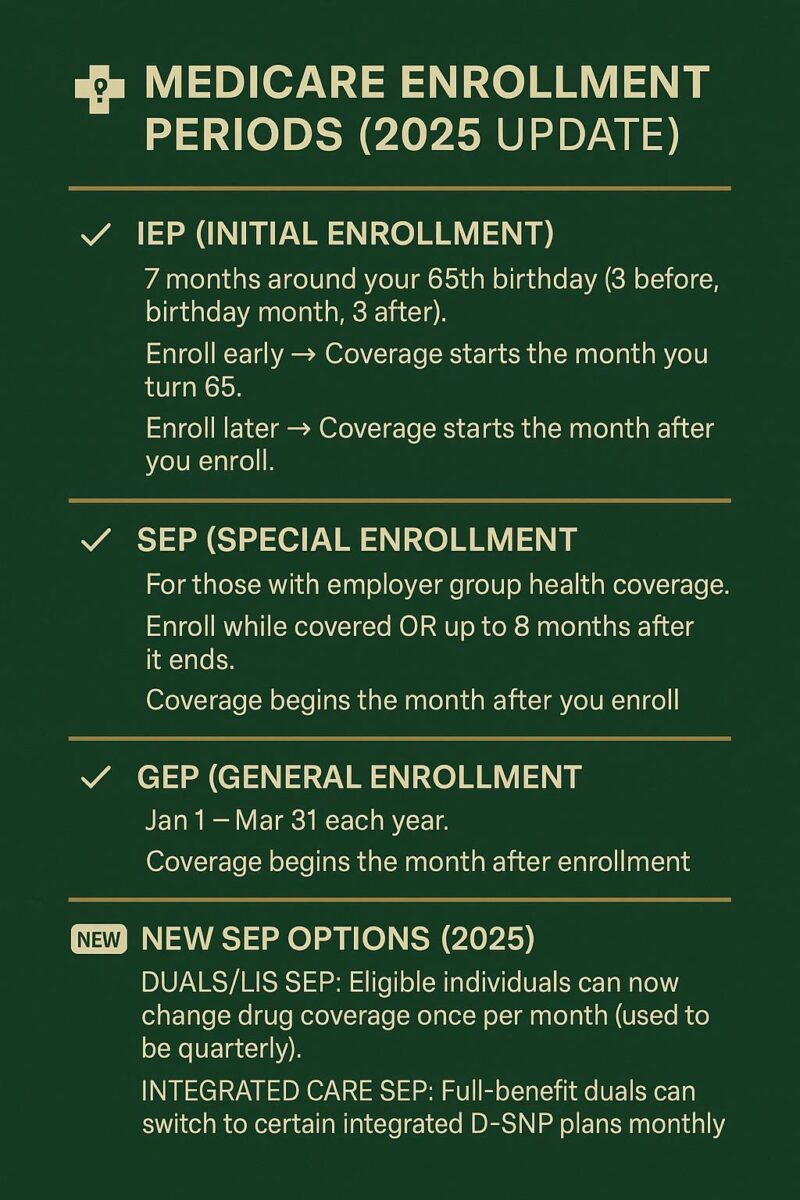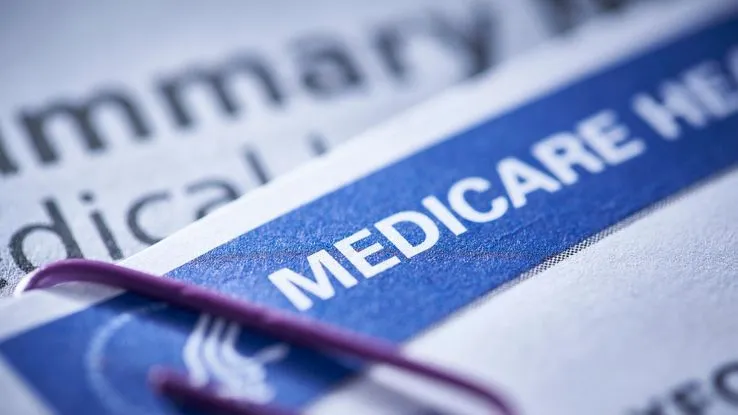Medicare made simple – personalized consultations to guide you through enrollment, appeals, and plan decisions with clarity and confidence.


Medicare is a federal health insurance program for people age 65 and older, and for some younger individuals with disabilities or certain medical conditions.
Understanding its different parts is the first step to making the right decisions:
Medicare isn’t one-size-fits-all — and if you feel you need more guidance understanding your options, we offer a $75, 30-minute consultation to walk you through it step by step.
Note: Part C and Part D plans must be selected with the help of a qualified, certified Medicare Supplement specialist. We don’t sell these plans ourselves — but we’ll happily refer you to a trusted expert. Just ask — we’re here to guide you in the right direction.
Our consultation is designed to answer all your questions and help you make confident decisions. We assist with:
General Question Consultation – $75 (30 minutes)
Best for:
Understanding Social Security rules & eligibility
Medicare enrollment issues
IRMAA appeal guidance and form support
Retirement planning Q&A
Designed for quick, focused answers to specific questions from current or future beneficiaries.


Extra Help is a federal program to lower or eliminate Part D premiums based on income and resources. You may qualify if your income and assets are below limits, and it can reduce cost-sharing and deductibles.
Extra Help reduces out-of-pocket costs for Medicare Part D, including premiums, deductibles, coinsurance, and copayments. It is estimated to save beneficiaries approximately $6,200 per year on average.
• Premiums: Full or partial coverage of Part D plan premiums (up to a benchmark amount, which varies by state).
• Deductibles: No or reduced annual Part D deductible (no plan can have a deductible exceeding $590 in 2025).
• Copayments/Coinsurance: Reduced copays, capped at $4.90 for generic drugs and $12.15 for brand-name drugs in 2025. Once out-of-pocket costs reach the catastrophic coverage threshold ($2,000 in 2025), no further copays apply.
• No Late Enrollment Penalty: Beneficiaries are exempt from the Part D late enrollment penalty while receiving Extra Help.
Those with Extra Help can switch Part D plans once per quarter (January–September) and during the annual Open Enrollment Period (October 15–December 7), with changes effective the following month.
Live in one of the 50 U.S. states or the District of Columbia (Extra Help is not available in Puerto Rico, U.S. Virgin Islands, Guam, Northern Mariana Islands, or American Samoa, but other programs may apply).
Be enrolled in Medicare Part A and/or Part B.
• Single: Annual income less than $23,712 (approximately $1,976/month).
• Married, living together: Annual income less than $31,968 (approximately $2,664/month).
• Higher limits apply in Alaska and Hawaii, and exceptions may exist for those with dependents or who are still working.
• Single: Resources less than $17,600.
• Married, living together: Resources less than $35,130.
• Resources include: Savings, checking accounts, stocks, bonds, mutual funds, IRAs, and real estate (excluding primary residence).
• Resources exclude: Home, car, household items, burial plots, up to $1,500 per person for burial expenses, and life insurance policies.
• Beneficiaries automatically qualify for Extra Help if they:
• Have full Medicaid coverage.
• Are enrolled in a Medicare Savings Program (e.g., QMB, SLMB, QI).
• Receive Supplemental Security Income (SSI) benefits.
• These individuals receive a purple notice from CMS confirming automatic enrollment and do not need to apply.
Those with Medicaid, SSI, or a Medicare Savings Program are automatically enrolled and notified by CMS. Medicare may also auto-enroll them in a benchmark Part D plan if they lack drug coverage, though they can choose a different plan.
• Others must apply through the SSA:
• Online: At www.ssa.gov/extrahelp.
• By Phone: Call 1-800-772-1213 (TTY: 1-800-325-0778), Monday–Friday, 8 a.m.–7 p.m.
• In Person: Visit a local SSA office.
• Applicants provide financial information (income and resources). A decision letter is typically mailed within three weeks.
If income or resources change, beneficiaries can reapply at any time. Those already enrolled remain eligible through December 31, even if income changes mid-year, and are reassessed annually.
If Extra Help status is incorrect, beneficiaries can submit proof (e.g., SSA award letter, Medicaid card) to adjust their subsidy level.
• Full Subsidy: No premium or deductible, and low copays ($4.90 generic, $12.15 brand-name in 2025).
• Partial Subsidy: Eliminated in 2024; all qualifiers now receive full benefits if income is up to 150% FPL.
• After reaching the $2,000 out-of-pocket cap (set by the Inflation Reduction Act), no further costs apply for covered Part D drugs for the year.
Provides temporary Part D coverage (up to two months) for those who qualify for Extra Help but are not yet enrolled in a plan. Covers all Part D drugs and offers retroactive coverage to the Medicaid/SSI start date or last Part D enrollment. Beneficiaries can seek reimbursement for covered drugs purchased during this period by contacting LI NET at 1-800-783-1307 (TTY: 711).
• If a plan terminates or is no longer offered, Medicare may reassign beneficiaries with full Extra Help to a new benchmark plan, but those who chose their plan must enroll in a new one during the Open Enrollment Period (October 15–December 7) or a Special Enrollment Period (ending February of the following year).
• Beneficiaries can compare plans at Medicare.gov or call 1-800-MEDICARE (1-800-633-4227, TTY: 1-877-486-2048).
• State Pharmaceutical Assistance Programs (SPAPs): Some states (e.g., New York’s EPIC program) supplement Extra Help by covering additional costs or Part D-excluded drugs. For example, New York’s EPIC program covers Part D premiums up to $72.34/month in 2025 for LIS members and requires Extra Help enrollment.
• Contact state Medicaid offices or State Health Insurance Assistance Programs (SHIPs) at 1-877-839-2675 for local assistance.
• Expanded eligibility to 150% FPL starting in 2024, eliminating partial subsidies.
• Capped out-of-pocket Part D costs at $2,000 in 2025, benefiting Extra Help recipients.
• Limits insulin costs to $35/month and provides free adult vaccines under Part D since 2023.
In U.S. territories, alternative programs exist through state Medicaid offices.
• If charged incorrect costs, contact the Part D plan or 1-800-MEDICARE. Provide receipts for reimbursement claims under LI NET by calling the LI NET number: 1-800-783-1307
• For eligibility disputes, use the Best Available Evidence (BAE) policy to submit evidence to the plan or SSA; please note SSA only uses BAE in determining ongoing coverage under Extra Help with Medicare Part D and in certain IRMAA appeals.
If auto-enrolled in a benchmark plan, verify it covers your medications, as formularies vary. Contact 1-800-MEDICARE to switch if needed.
Those with Medicaid or certain employer/union plans may opt out of Part D to retain other benefits but should consult their Medicaid office to avoid losing coverage.
Eligibility is reassessed yearly. CMS or SSA will notify you if you no longer qualify or are moved to a new plan.
Only official SSA or CMS representatives handle Extra Help applications. Beware of scams and verify contacts through official channels.
Need help choosing Medicare enrollment timing → General Questions Consultation
Facing Part D coverage questions or eligibility for Extra Help → Benefit Consultation
Receiving IRMAA surcharges → Claim Filing / IRMAA Appeal Consultation
For IRMAA purposes, the Social Security Administration (SSA) recognizes specific life-changing events (LCEs) that cause a significant reduction in income and are generally outside a married couple’s control. These events must lead to a decrease in Modified Adjusted Gross Income (MAGI) and be verifiable to qualify for an adjustment to Medicare Part B and Part D premiums. Based on SSA guidelines and common scenarios, here are several LCEs that could apply, focusing on those typically beyond a couple’s voluntary control
Appeals Process Overview
Submit SSA‑44 within 60 days of IRMAA notice.
Provide evidence of income reduction.
If reconsideration is denied, higher appeals through OMHA are possible.

If one spouse passes away, the surviving spouse’s income often decreases significantly due to the loss of the deceased spouse’s Social Security benefits, pension, or other income sources. This is explicitly listed by the SSA as an LCE and is clearly outside the couple’s control.
This occurs when property that generates income (e.g., rental property, farmland, or business assets) is lost or damaged due to events like natural disasters (floods, hurricanes, wildfires), fraud, theft, or eminent domain seizure. The SSA recognizes this as an LCE, as these events are typically unforeseen and uncontrollable.
If a pension plan terminates or payments are significantly reduced due to the employer’s bankruptcy, insolvency, or plan restructuring, this qualifies as an LCE. For example, a company’s financial collapse or legal restructuring could eliminate or reduce pension benefits, an event outside the couple’s control.
While the SSA lists “work stoppage” as an LCE (e.g., retirement or job loss), involuntary situations like layoffs, company closures, or forced terminations are beyond a couple’s control. For instance, if one spouse is laid off due to corporate downsizing or a plant closure, this could significantly reduce household income.
A reduction in work hours or income due to circumstances like a company-mandated reduction in hours, a health condition preventing full-time work (if not voluntary), or industry-wide cutbacks qualifies as an LCE. For example, a spouse in a struggling industry (e.g., retail or manufacturing) might face reduced hours due to economic downturns.
If a couple received a large, non-recurring settlement payment in the IRMAA base year (e.g., 2023 for 2025 premiums) from an employer due to a business closure or bankruptcy, and their income subsequently drops, this qualifies as an LCE. The settlement inflates MAGI temporarily, but the ongoing income reduction is outside their control.
While less common, if a couple divorces or their marriage is annulled, the resulting separation of finances often reduces the individual’s income. The SSA lists this as an LCE, and it can be considered outside their control if driven by irreconcilable circumstances rather than a mutual decision to manipulate income.
To qualify for an IRMAA adjustment, the couple must file Form SSA-44 and provide documentation (e.g., death certificate, layoff notice, pension termination letter, or property loss records) proving the LCE and the income reduction. The SSA evaluates whether the event significantly lowers MAGI below the IRMAA threshold.
Voluntary actions, like choosing to retire early, reduce work hours for personal reasons, or sell income-producing property by choice, typically don’t qualify as LCEs, as they reflect decisions within the couple’s control. Similarly, market-driven investment losses (e.g., stock market declines) are not considered LCEs, as they don’t fall under the SSA’s specific categories.
A couple’s rental property generating $20,000 annually is destroyed in a 2025 hurricane, eliminating that income stream. They can file Form SSA-44 with insurance or FEMA documentation to adjust their 2026 premiums.
One spouse’s employer goes bankrupt in 2025, terminating a $30,000 annual pension. The couple can submit bankruptcy court documents or a pension termination notice to the SSA.
A spouse is laid off in 2025 due to a factory closure, reducing household income by $50,000. A layoff notice or unemployment benefits record would support their SSA-44 filing.
Navigating Social Security and Medicare can be confusing — but you don’t have to do it alone. At Bragg SSC, you’ll work directly with a dedicated consultant who listens, understands, and provides expert guidance tailored to your unique situation. We’re here to make the process simple, stress-free, and in your best interest.
You get expert advice designed around your specific needs
We work for you — not insurance companies or third-party providers.
Get clarity from a professional who’s helped hundreds of individuals and families

Helping individuals and families make sense of Social Security and Medicare.
Stay informed with updates on Social Security changes and tips — straight to your inbox.
© 2025 Bragg Social Security Consulting. All rights reserved.